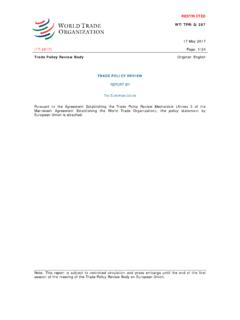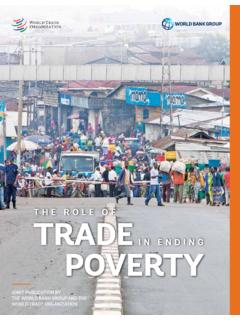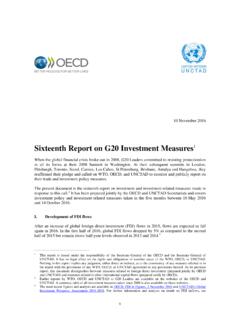Transcription of AN ECONOMIC ANALYSIS OF THE US-CHINA TRADE CONFLICT
1 Staff Working Paper ERSD-2020-04 19 March 2020 _____ World TRADE Organization ECONOMIC Research and Statistics Division _____ AN ECONOMIC ANALYSIS OF THE US-CHINA TRADE CONFLICT Eddy Bekkers and Sofia Schroeter ECONOMIC Research and Statistics Division World TRADE Organization Manuscript date: 26 February 2020 _____ Disclaimer: The opinions expressed in this article should be attributed only to its authors. They are not meant to represent the positions or opinions of the WTO and its Members and are without prejudice to Members rights and obligations under the WTO.
2 Any errors are attributable to the authors. Address for correspondence: Eddy Bekkers, Rue de Lausanne 154, 1211 Geneve, Switzerland. email: We want to thank Marc Bacchetta, Coleman Nee, Robert Koopman and Robert Teh for useful comments and suggestions. Disclaimer: The opinions expressed in this article should be attributed only to its authors. They are not meant to represent the positions or opinions of the WTO and its Members and are without prejudice to Members rights and obligations under the WTO. Any errors are attributable to the authors. AN ECONOMIC ANALYSIS OF THE US-CHINA TRADE CONFLICT Eddy Bekkers and Sofia Schroeter ECONOMIC Research and Statistics Division World TRADE Organization ABSTRACT This paper provides an ECONOMIC ANALYSIS of the TRADE CONFLICT between the US and China, providing an overview of the tariff increases, a discussion of the background of the TRADE CONFLICT , and an ANALYSIS of the ECONOMIC effects of the TRADE CONFLICT , based both on empirics (ex post ANALYSIS ) and on simulations (ex ante ANALYSIS ).
3 Bilateral tariffs have increased on average to 17% between the US and China, and the Phase One Agreement signed in January 2020 between the two countries only leads to minor reductions in the tariffs to 16%. The TRADE CONFLICT has led to a sizeable reduction in TRADE between the US and China in 2019 and is accompanied by considerable TRADE diversion to imports from other regions, leading to a reorganization of value chains in (East) Asia. The simulation ANALYSIS shows that the direct effects of the tariff increases on the global economy are limited ( reduction in global GDP).
4 The impact of the Phase One Agreement on the global economy is even smaller, although the US is projected to turn real income losses into real income gains because of the chinese commitments to buy additional US goods. The biggest impact of the TRADE CONFLICT is provoked by rising uncertainty about TRADE policy and the paper provides a framework to analyze the uncertainty effects. Keywords: TRADE CONFLICT , ECONOMIC simulations, TRADE effects of tariffs JEL-codes: F12, F13, F14, F17 Address for correspondence: Eddy Bekkers, Rue de Lausanne 154, 1211 Geneve, Switzerland. email: We want to thank Marc Bacchetta, Coleman Nee, Robert Koopman and Robert Teh for useful comments and suggestions.
5 Disclaimer: The opinions expressed in this article should be attributed only to its authors. They are not meant to represent the positions or opinions of the WTO and its Members and are without prejudice to Members rights and obligations under the WTO. Any errors are attributable to the authors. 1 INTRODUCTION Since 2018 the United States and China have imposed various restrictive measures on TRADE flows between the two countries, of which increases in tariffs have been most prominent. Tariff increases by the United States on chinese imports led to a quick response of China, also raising its tariffs on American imports.
6 Although the TRADE CONFLICT seemed to escalate in the Fall of 2019 with new tariff increases, at the end of 2019 the two countries agreed on a truce, cancelling some of the announced tariff increases and rolling back some of the earlier increases in tariffs. The truce led to the so-called Phase One Agreement signed in January 2020. This paper analyzes the economics of the TRADE CONFLICT , discussing the ECONOMIC background of the TRADE CONFLICT , providing an overview of the different measures taken and exploring the ECONOMIC effects, going into the impact already generated (ex post ANALYSIS ) and the impact expected in the future (ex ante ANALYSIS ), paying special attention to the possible effects through uncertainty about TRADE policy.
7 The ECONOMIC effects are examined both reviewing the literature and doing own ANALYSIS . For the ex post ANALYSIS , we explore how TRADE flows between China and the US have changed over the last two years and we analyze patterns of TRADE diversion. For the ex ante ANALYSIS , the WTO Global TRADE Model (GTM), a recursive dynamic computable general equilibrium (CGE) model, is employed. There is extensive discussion about the potential effects of the TRADE tensions on the global economy through rising TRADE policy uncertainty and we incorporate the framework proposed by Handley and Limao (2017) into the Melitz firm heterogeneity version of the GTM in simplified form.
8 In particular, rising TRADE policy uncertainty is modelled through an increase in the discount rate triggering an increase in fixed export costs for given sunk export costs. In the ex ante ANALYSIS , we develop four scenarios to be able to evaluate the impact of the Phase One Agreement and to assess the impact of rising TRADE policy uncertainty. Since the start of the TRADE CONFLICT between the US and China the two countries have raised tariffs substantially on each other's exports, from to on chinese imports into the US and from to on us imports into China. The Phase 1 Agreement between the US and China reduced the tariffs on chinese imports into the United States to 16%.
9 To limit the scope of the paper, it focuses on the TRADE tensions between the US and The tariffs on chinese imports have been motivated with at least four arguments: (i) address bilateral TRADE imbalances; (ii) make tariffs more reciprocal; (iii) bring back manufacturing jobs; (iv) address chinese policies with negative spillovers such as poor IP protection, subsidies of state-owned enterprises, and forced technology transfer. The ECONOMIC underpinning of the first three arguments will be discussed in detail in the paper. Although TRADE flows from China to the US still increased in 2018 because of frontloading by about 7%, exports from China to the US fell substantially in the first three quarters 2019 for tariffed goods, by 13%.
10 US exports to China fell by about 1% in 2018, accelerating to a reduction of more than 25% in the first three quarters of 2019. While chinese exports to the US still increased in 2018 by 7% because of frontloading, they dropped in the first quarter of 2019 by about 13%. The ex post ANALYSIS also shows that there was significant TRADE diversion towards imports from other trading partners. Four East Asian countries (Japan, South Korea, Taiwan, and Viet Nam) exported less to China and more to the US, in particular in the electrical equipment sector. This indicates that value chains in East Asia are reorganized in response to the TRADE CONFLICT .









